|
FAQs on
Black Ghost
Knifefish, Apteronotus (Sternarchus) albifrons, Disease/Health:
Diagnosis
Related Articles:
New World Knifefishes,
Gymnarchus,
Notopterids/Clown Knifefishes
Electrogenic Fishes,
Related FAQs: BGK Disease 1,
BGK Disease 2,
BGK Disease 3, BGK Disease 4,
Knifefish Disease,
FAQs on
BGK Disease by Category:
Environmental,
Nutritional,
Social,
Infectious,
Parasitic, Trauma,
Treatments,
FAQs on:
BGK ID,
BGK Behavior,
BGK Compatibility,
BGK Selection,
BGK Systems,
BGK Feeding,
BGK Reproduction, &
Knifefishes 1,
Knifefishes 2,
Knifefish Identification,
Knifefish Behavior,
Knifefish Compatibility,
Knifefish Selection,
Knifefish Systems,
Knifefish Feeding,
Knifefish Reproduction,
Electrogenic Fishes,
Notopterid Knifefishes
(Clowns...),
|
|
|
Black ghost knife may be sick 4/19/19
My black ghost knife has recently transferred into a new tank but has so far
been comfortable and seems happy in his new home. He ate a few fish within the
first few days of being in the tank but otherwise has had a steady diet.
<Please do not use feeder fish! Indeed, eating any sort of live fish, whether
cheap feeders or pet fish massively increases the risk of health problems.>
Recently I checked on him at night when he was active and his skin appears to be
a grayish colour with white splotches. It's like that on both sides of his body.
Is this normal?
<No.>
And if not how can I treat it, he is a very important thing in my life and I
would do anything to make him better if he is sick. Pleas help
<Grey patches of slime usually indicating some type of irritation to the skin.
It's similar to a human getting an inflammation or rash. And like a rash, it's a
symptom rather than a specific disease. Environmental stress can cause this, but
more often it's some type of infection. Costia (Ichthyobodo) is a common cause,
and often called Slime Disease because of this. Various medications exist for
this; I like eSHa 2000, but something like ParaGuard would be a good
alternative. Seachem recommend starting with one-half or even one-quarter
dosages with sensitive fish, and only increasing upwards to the full dose
as/when require and if you're comfortable the fish is tolerating the medicine
well. I'd support that approach, given the type of fish you're keeping here.
Cheers, Neale.>
|
.jpg) .jpg) |
|
Bump on Black Ghost Knife Abdomen
4/24/17
Hi WWM Crew,
<Mercedes>
I purchased a Black Ghost Knife about a 6 weeks ago, and have become quite
fond of it. I was feeding him today, and my roommate noticed that he has a
strange bump on his abdomen.
<I see this... too far forward to be a "gout/thyroid" issue... perhaps gut
blockage of some sort; hopefully not viral/tumorous>
There is also a smaller one on the other side.
One side looks a bit gray-ish though. I've attached a video (00:19 & 00:27
the larger bump, 00:38 the smaller bump) and a couple of photos. All of the
water parameters look good, and he's very active. I feed him frozen
bloodworms, some Hikari freeze dried bloodworms
<I would hold off or delete the sewer fly larvae (bloodworms); implicated
too often in disease. See/search WWM Re. Sub. other meaty foods. See WWM re
BGK foods/feeding/nutrition FAQs>
occasionally, and bits of Omega One freeze dried shrimp. Can you tell me
what caused this bump and discoloration?
<Not w/o dissecting the specimen>
Could it be the gravel substrate? How can I help it go away?
<Eschew the bloodworm use and try Epsom salt is what I would do. Please read
Neale's piece here re:
http://www.wetwebmedia.com/fwsubwebindex/SaltUseFWArtNeale.htm
Thanks,
Mercedes
<Welcome. Bob Fenner>
IMG_5956.MOV
<https://drive.google.com/file/d/0B-OBJM3bjqnSdlFIeUhPVGN5YWs/view?usp=drive_web>
[image: Inline image 1][image: Inline image 3]
|
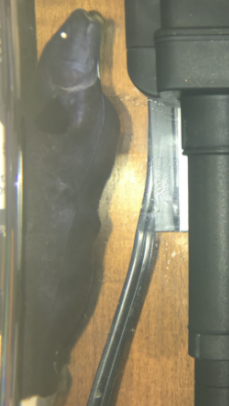 |
|
BGK with white stringy faeces & weight loss
2/17/17
Hello
<AJ>
I have had my BGK for 5 years and he has thrived until
recently - about 2 months ago he began to lose his usually voracious
appetite, became lethargic and developed white stringy poop. (I had an issue
with high nitrates a little while ago and I think this may have been what
stressed him, but I've gotten the water conditions back to normal
now - pH 6.4,
Ammonia 0, Nitrite 0, Nitrate 10-20 (I hope the pH isn't too acidic?
<Should be okay; as long as steady (not erratic, precipitously dropping....
I take it you do have measurable alkalinity)>
but the tap water is 6.8 and I don't want to artificially raise it).
<Not necessary, nor advised here>
Don't know the hardness but I know the tap water is quite soft.
<I would just be rigorous re regular/frequent partial water changes... See
WWM re S.O.P.s and cautions>
I treated with Metroplex for 14 days (until I ran out) - by
medicating his food + adding to tank water, but he refused the medicated
food and now isn't really eating at all.
<This dearth of appetite might be from the Flagyl exposure alone. I would
cease it... too hard on fish (and human) "kidneys">
I have since run out of Metroplex and am waiting for more to arrive from the
US (can't get it without a prescription
here in Australia and the veterinarians won't give me a script as they don't
deal with fish). I also added salt to the tank at 1gram/litre. He has shown
some improvement and does show interest in his regular (unmedicated) food -
frozen "community food" - this one:
http://www.fishfuelco.com.au/products/community-food/ , bloodworm,
freeze dried Tubifex - but then just spits it out. He is also back to his
usual alert and active self, but the stringy poop remains and I am really
worried because he has lost so much weight and still isn't eating. Can you
suggest any other foods to tempt him?
<Yes; live small worms and crustaceans if you can get them>
What about live foods (he made short work of some neon tetras I foolishly
put in the tank a couple of years ago - oops).
<These/live foods are best here>
When the new supply of Metroplex arrives I've been wondering about trying to
dose him directly with a tuberculin syringe but I'm afraid I could hurt him
or worse. Any advice on this?
<I would NOT continue this treatment; as stated above>
I'm just doubtful that the Metro is going to have any effect unless I can
get it into him, so I don't know what else to do. Should I be trying some
other medication / treatment altogether? I don't want to lose him! I've
attached 2 photos that show some of the poop hanging from him - and how
skinny he is :-(
Thanks for your time.
AJ
<"Stringy poops" can be due to many influences; not simply
pathogenic. I would focus on water quality, get and use live foods and leave
off w/ further Metronidazole exposure. Bob Fenner>
|
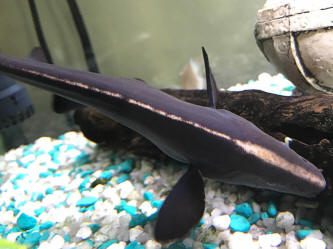
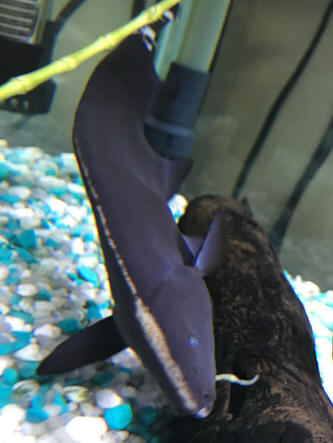
|
Re: BGK with white stringy faeces & weight loss
2/19/17
Thanks for your fast reply. Unfortunately in the last 24hrs he has taken a
turn for the worse and is now panting/has rapid respiration. The water is
well oxygenated and there have been no changes to the water chemistry. He
also now appears bloated, like he has a belly full of food (which he doesn't
since he hasn't been eating). I did a partial water change and
have added Epsom salt @ 1g/L. Please see attached photos showing his belly.
<I see this in your excellent pix. I'd increase the Epsom as per here:
http://www.wetwebmedia.com/fwsubwebindex/SaltUseFWArtNeale.htm
Bob Fenner>
|
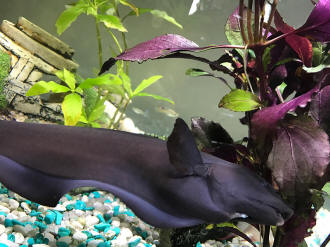
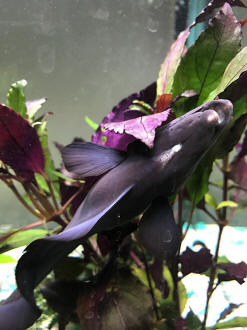 |
|
Black ghost knife... Camallanus trtmt.
5/3/16
Hi! I'm having a real problem with my black ghost knife! We
recently got Camallanus worms in our tank (still not sure where it came
from).
<Other fish/es most likely; possibly from live or improperly processed
frozen foods (gamma irradiation, deep freezing...)>
We just treated our tank with Levamisole HCI powder yesterday.
<Mmm; I'd try Prazi/quantel first>
It told us to cover the tank for 24 hours to let no light in. Well we
just removed the blankets, and our BGK seems to have a large
lump where his 'neck' would be.
<Perhaps goiter (see WWM re; the search tool); or consequent a physical
injury>
He also seems to keep his face pointed inside the bubbles. Any idea if
this is normal or not?
<Mmm; poisoning of some sort... the usual defaults suggested,
water change/s, use of GAC... Bob Fenner>
Thanks!!!
Emily Galloway
|
Hole with red white strings on ghost knife
2/6/15
My buddy sent me this photo. His black ghost knife has a hole with red and white
strings hanging out under his body near the mouth. I checked your site and the
web and can't find anything on it. Can you help? Sorry pic is terrible .
<Indeed it is! But short answer, likely a combination of physical damage
(scratched by rocks, nipped by tankmates, etc.) and environmental shortcomings
of some sort (non-zero ammonia and nitrite for example). To be clear: most
problems with Black Ghosts are down to three things: [a] the way they're kept,
[b] the way they're kept, and [c] the way they're kept.
In and of themselves they're not particularly prone to disease or plagued with
parasites upon import. But they are highly demanding fish. Let's go through what
your buddy needs to provide. Firstly, a big aquarium, 55 gallons would be too
small, 75 gallons for an adult a bare minimum, and anything up that much the
best option. Juveniles don't last long in small tanks (20 gallons for example)
and usually end up dead under such conditions, so even if this is a youngster,
you'd be starting off with 40, 50 gallons and upgrading quickly. Next up,
filtration. As fish from rapids and riffles and places around waterfalls, they
like water movement and high oxygen levels. Big canister filters and the like
are what you're after.
Turnover rates upwards of 8 times the volume of the tank per hour. Low nitrates
are a plus, so regular water changes. Water chemistry itself isn't a big issue,
so you can be liberal with water changes even in moderately hard water areas.
Diet is a big problem for many folks. While they sometimes take pellets, they're
mostly micro-predators and expect a varied diet based around insect larvae,
small earthworms, enriched brine shrimps and so on. A monotonous diet based on
frozen bloodworms for example won't work though. Definitely no feeder fish!
Because they can't be medicated with anything containing copper or formalin, you
need to avoid situations where these might be needed. Quarantine tankmates
(better yet, avoid them) and ensure there's nothing in the tank that could
damage them (sharp rocks, for example). I'm guessing yours has some sort of
ulcer, perhaps caused by gravel (don't use gravel, use smooth silica sand) or
jagged rocks (provide
lots of smooth caves in the form of plastic or ceramic pipes). An antibiotic
will be necessary, and don't use anything else unless it expressly states it's
safe with stingrays (most aquarium store medications aren't). Remember to remove
carbon from the filter while medicating.
Cheers, Neale.>
|
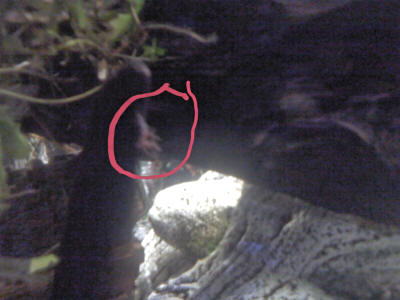 |
|
Re: Hole with red white strings on ghost knife
2/7/16
Thanks! He does have gravel.
<Check how fine and/or sharp the gravel is before panicking. But given they feed
by exploring the substrate, anything that can scratch their snout or chin can
easily turn into an ulcer.>
He thought a clown loach might be the one causing it.
<Not really compatible. Much too boisterous and likely to consume the same foods
at the same time. Plus, Clowns are schooling fish, and a group of, say, 5
specimens will put a massive load on the biological filter. Much better to keep
Black Ghost Knifefish on their own or with day active midwater species such as
the larger characins (Silver Dollars, Bleeding
Hearts, Congo Tetras, etc.).>
I see just by reading your email he has several things that need to be
corrected. Thanks for the info
<Most welcome. Cheers, Neale.>
|
Ghost Knife issue... hlth. concern
6/10/15
Hello,
<Shahn>
Hoping you can help.
<Me too>
I have a 28cm ghost knife who is around 5 years old living in
my 250 litre tank with several discus fish and angels and a few catfish
cleaners. In the recent 3 months my ghosty has shown several like blood
spots on his tail and now has a few more initially I presumed that my
sucker fish were sucking algae off him and therefore creating blood type
blisters but it is getting worse.
Any idea's on what it is and how to treat?
<I concur re your guess that this fish is likely being traumatized. What species
of catfish are present? Does you Ghost have a cave/place of its own? Is this
near where the Discus, Angels hang out? Bob Fenner>
Regards
Shahn
Re: Ghost Knife issue 6/10/15
Dear Bob
<Shahn>
Yes my Ghost does have many places to hang out and hide as the tank was set up
mainly for him and my discus and the other fishies are 'add ins'.
<Ah good>
The cat fish are bristle nose but I am starting to think that it is possibly my
5 loaches doing it as they are the golden sucking loaches.
<Well; may be the loaches, not strange that these should go after an
Apteronotid... is it possible that some element of the decor (sea shell, sharp
rock) has cut into the knife?>
Your help is appreciated.
<Glad to assist. Bob Fenner>
Black Ghost knife fish has strange lumps Help ?
4/20/14
Hi guys, I have a 200L tropical tank that I have had for over 10 years,
unfortunately most of my large fish have perished (old age I think) so I
only have a clown loach, a huge black spotted Pleco, a little black
widow
and my black ghost knife fish,
<Do suspect 'old age' isn't directly to blame -- most of the fish you
name should live 10-20 years. Aquaria have a carrying capacity, dictated
by things like filtration, water turnover, water changes, and so on. A
key question here is what you mean by "200L". In the metric world, 200 L
would be 200 litres, about 50 or so US gallons, which is obviously far
too small
for this collection of fish! Americans often use the letter "L" after an
aquarium to denote a "long" rather than "deep" aquarium, but I've never
come across a 200 gallon "long" aquarium because there isn't anything
called a 200 gallon "deep" aquarium so far as I know. So, confusion
reigns!
In any event, a school of Clown Loaches (they're social fish), a large
Plec, an adult Black Ghost, and an assortment of smaller characins could
be kept in 200 gallons, but I really don't have any idea what fish you
started with or how many of them. My hunch would be "too many" in some
sense, and the population of fish has simply died back to what the
aquarium, filter, and your maintenance regime will support.>
I got them all around the same year so the Knife fish is at
least 9yrs old. I do weekly water changes and have a canister
filter. Over the last year my Black ghost has developed these strange
lumps that come and go ?
<Possibly Lymphocystis or some other viral-type infection if the cysts
are relatively clean (no dead skin, no sign of Fungus or Finrot). Viral
infections aren't normally deadly, and there are no treatments, but they
can indicate problems with the environment, sometimes chemicals in the
water (e.g., heavy metals) but equally likely sub-lethal, long-term
stresses like water quality issues or the wrong water chemistry. Age can
be a factor, and a Black Widow Tetra would have a life expectancy of
around 5 years, though like you, I've seen occasional specimens from an
original group live much, much longer that all the others.>
They are often on both sides in different locations and different sizes,
they seem to be under the skin ? He/she seems fine otherwise, eating
normally, hiding during day and out in the evenings. I have read through
multiple articles on your site and web but failed to find the right
info, I also went to local fish shop and they said "its probably old age
?" I'm just very worried and don't want to lose him Any info would be
greatly appreciated :)
<For a start check water quality; obviously nitrite/ammonia but also
nitrate. Do have your retailer check for copper in the water too, as
this could be a problem but it isn't really worth buying a kit if you
don't plan on checking regularly. Check your water conditioner removes
heavy metals. Look at the substrate; some cheap gravels and decorative
rocks can contain
traces of metals. Remove if found. Check the pH is stable. Your fish
aren't too fussed, but it shouldn't be above 8, and in any case should
be steady from week to week. Review filtration. Unless you have a
MASSIVE filter, like a Fluval FX6, you definitely aren't going to have
the water turnover you need from one filter. A 200-gallon tank would
need at least a turnover
rate of 6 times per hour, and 8-10 would be ideal, so a filter rated
upwards of 6 x 200 = 1200 gallons/hour. Lack of turnover may not mean
water quality is poor, but it may mean that oxygenation isn't
sufficient, with water at the bottom of the tank not really flowing
briskly as it should. If all else fails, installing a couple of
inexpensive powerheads (as used in marine tanks) can up the water
turnover rate, especially if positioned at "dead spots" at the bottom of
the tank. Apteronotus albifrons is a classic
riverine fish that demands high levels of water current and lots of
oxygen.>
Thank you all so much
<Most welcome, Neale.>
re: Black Ghost knife fish has strange lumps Help ?
4/20/14
Hi Neale thank you so much for taking the time to reply,
<Welcome.>
Just to clarify because I have confused you, it is a 200 litre tank and
the canister filter is 1200 liters/per hour :)
<Nice filter; excellent turnover rate; tank too small for this/these
fish.>
also wanted to let you know that about one month ago after reading your
on your site I suspected that the bloodworm & brine shrimp I was buying
from my local pet shop might be refrozen (half full blister packs and it
looked dry and discoloured on top) so I went to another shop and
purchased bloodworms & brine shrimp which clearly looked much nicer
(bright in colour and full blister packs)
<Indeed; they do vary, and they do age even in the freezer.>
After feeding the new food the lumps were gone basically within 48hrs
but returned again about 3 weeks later. I also have a large round
airstone disc running in the tank. I purchased the natural gravel and
ornaments from a reputable fish dealer and didn't buy the cheaper of the
two. The lumps do look clean, I also only use good API water products
(stress coat, quick
start etc) so they remove heavy metals but I do live in Western
Australia in a 30 year old house so copper is definitely something I
should look at,
<As in the UK; not normally a problem if you use a water condition that
removes copper (most do these days, but check).>
I have a full test kit so I will test everything you have asked me too,
I do have to admit I have been very slack on water testing as I have not
had any problems or fish loss up until the last year or so, I will get
back to you with the results asap, again thank you so much !
<Cheers, Neale.>
Black Ghost Knife has lump on side 6/19/12
I have a well established tank. Nobody bothers my ghost knife. I
have had him for about 5 years. He is approximately 8 inches
long. I just noticed what looks to be a tumor on his side behind his
fin. It seems to have appeared almost overnight. His behavior has not
changed. I don't know if I am paranoid or if he is breathing heavy. I
just did a water change but plan to do another and I will add aquarium
salt to the tank. I would hate to lose my Ghost Knife but I do not want
him to suffer. What should I look for and what can I do. Please help.
Thank You, Gina
<The Black Ghost Knifefish, Apteronotus albifrons, is a very difficult
fish to keep well. Of the thousands of specimens sold in pet shops,
hardly any live as long as yours, and I'm sure most die within a year of
import. On top of this, you almost never see full-sized adults (which
should be at least 40 cm/15 inches long). So what's the deal? The first
issue is that these fish need spotlessly clean, oxygen-rich water. They
come from the rapids and riffles around waterfalls, and while they may
get enough oxygen from an average aquarium when small, as they grow,
they quickly become starved of oxygen because the tank isn't big enough
for them (or overstocked, or under-filtered, or lacking circulation).
Excessive heat does them no good too; they're best kept a trifle cool,
around 24-25 C, rather than 28 or 30 C. What else? They're very
sensitive to medications of most sorts, including copper, formalin, and
many of the organic dyes used in commercial fish medications. There's
not nearly enough information about your aquarium for me to diagnose the
problem here, but I hope this gives you some clues about what might be
wrong, so you can go away and review your aquarium. Meantime, have a
read here:
http://www.wetwebmedia.com/fwsubwebindex/bgkbeh.htm
Then follow the links at the top of the article to other FAQs that might
help. Cheers, Neale.>
black ghost knife fish, hlth./beh.
11/15/11
My black ghost knife fish has been happily living in my tank af 2
years.
The other day he started twirling in a vertical
stance. Days later he is still in a vertical position. It is
as if his floating bladder is haywire. He can't go lay on the
bottom as normal and I don't think he can get anything to eat.
Is there any hope or treatment? Or is he going to starve to death? Any
cure for the unbalance?
thanks for any help,
<Need some information on his aquarium, Jerome. For example, how big
is the tank? What is the water chemistry and temperature? What are the
water quality statistics? Have you used any medication recently? This
sort of "twirling" usually means two things: an acute
reaction to some poison in the water (e.g., copper, formalin, ammonia)
or else the fish is so sick it's lost motor control. In the first
scenario, multiple water changes to dilute the toxins can, should help.
In the second scenario, the future is bleak without a good idea of why
the fish is sick. Cheers, Neale.>
Bloated black ghost knife fish
02/02/10
Hi
<Hello,>
I'm wondering if you can help me as I can't find an answer
anywhere. We have a Black Ghost Knife Fish who is about 4 years old now
and is a rather big boy. We have noticed his belly has really bloated
up. I have been told
it could be constipation or over feeding.
<Possibly; switch to just high-fibre foods. While cooked peas
aren't likely to be eaten, live brine shrimp and live daphnia are
almost as good, and more readily accepted by carnivorous fish. Live
earthworms with a gut full of mud should be very good too, but collect
from somewhere safe, i.e., not sprayed with pesticides.>
Is this a common problem with these fish, he has never been like this
before.
<The problem with Apteronotus albifrons is most people don't
keep them alive for very long. They are extremely demanding fish, and
while juveniles can do just fine in a community tank, as they mature,
their demands become
more difficult to meet. Remember that these fish come from shallow,
fast-flowing water, so they're used to high oxygen levels and
spotlessly clean conditions. Water flow rates should be very high,
upwards of 8 times the volume of the tank per hour, and adding
additional airstones or powerheads to provide additional water flow
near the bottom of the tank wouldn't be a bad idea at all. By
contrast, the average 55 gallon tank with some cheap-and-cheerful
hang-on-the-back filter just isn't going to cut it.
Hence, these fish often do live a year or two in captivity, but rarely
the full 15 years, and only very occasionally do you see truly mature
fish up to 50 cm long.>
He also seems to be gasping for air a little but I'm guessing
that's the pressure on his little lungs. What can I do to help him.
?
<If he's gasping for air, that's a very good indication
water quality *at the bottom* of the tank is poor. Review water
current. Add some flake to the bottom of the tank; if it just sits
there, you have a problem. Think of water flowing through some rapids:
that's what you're after!>
I have just done a 50% water change encase it's the water quality
but I have many other fish including Clown Loaches and they are all
fine. I also got told it could be Tuberculosis but ????
<Very, very unlikely to "Fish TB", or one of the other
Mycobacteria infections. Water quality issues, too much heat (should be
around 22-24 C), and of course poisoning (e.g., the use of copper-based
medications) are all much more probable. I'd also review diet,
since carnivorous fish can suffer malnutrition rather easily. Variety
is central, and avoiding risky live foods critically important. Cheers,
Neale.>
Black Knife Ghost Fish, hlth., need data
5/8/2009
Hello crew, I writing to you about my BKGF.
<Apteronotus albifrons, an interesting but delicate species from
shallow, fast-flowing habitats. It's crucially important this
species is kept in a big (55+ gallons) tank with a very strong
filtration system rated at 8 times the volume of the tank in turnover
per hour. So for a 55 gallon tank, the filter (preferably an external
canister filter) would need to be rated at 440 gallons/hour. Almost all
failures with this species come down to [a] keeping them in too small
an aquarium; and [b] not providing adequate filtration. Water chemistry
isn't critical, but ideally should be soft to moderately hard, pH
6-7.5. Water temperature should be middling, around 25 C.>
I got him about a week ago and seemed fine until 2 days ago.
<Hmm...>
He now seems to struggle swimming and kind of looks like the end of his
tail or back is broken. His lower fin wont move like it usually now he
looks like he really struggles to move around and sometimes he just
lays down at
the bottom of the tank. Is this some sort of illness, or could it be
that he got into a fight with the other fish and broke its back?
<Need some information on the size of the tank, the filter used, the
water quality, and the companion fish in this system.>
Please I need some advised, I don't want to lose this fish.
<Cheers, Neale.>
Black Ghost Knife 9/15/08
Good Evening,
I have a black ghost knife that has been in the same 30 gallon tank for
10 years, he was a baby when we got him. He has always been quite happy
and not aggressive. Today I noticed he is at the top of the tank and
has a bloated underbelly. He is upside down and laying on top of the
underground filter, but he is still alive. Can you tell me what this is
and if there is anything we can do for him?
Thank you,
Karla
<Hello Karla. Since you've maintained this fish a fair while,
I'm loathe to be too critical, though I will make the point that 30
gallons isn't much space by the standards of this species. So your
first job would be to test the water chemistry and quality. In
particular I'd be looking for signs that the filter is now
overloaded by the growth of the fish (i.e., you detect nitrite).
I'd also check to see if the pH is still where it should be;
overstocked tanks tend to show much faster drops in pH caused by the
various acidification processes. I'd do a 50% water change at once
-- taking care that water chemistry and temperature of the new water
aren't much different to the old water. I'd also review any
possible sources of poisoning: food past its sell-by day, use of paint
in the house, bug sprays, etc. A photo would help us to gauge the
overall condition of the fish, but because Apteronotus are notoriously
sensitive to water quality, that's what I'd examine first. If
he peps up after a 50% water change, maybe doing more water changes for
the next day or two, I'd wager that water quality or water
chemistry stability are the issues and act accordingly. Cheers,
Neale.>
Black ghost knife fish 8/13/13
I just got a black ghost knife fish as a gift from my daughter but he
seems unhappy just laying around and hiding all the time also he keeps
getting stuck to the filter and seems unable to swim right like the
bubbles are pushing him around...do I have a problem?
<Hello Jessica. Possibly unfortunately for you, Black Ghost Knifefish
are notably challenging fish to keep. They need a large aquarium (think
55+ gallons at minimum), excellent water quality (no ammonia or nitrite,
plus substantial weekly water changes), an understocked aquarium, and
the right sort of food. Without any specifics on your aquarium, I can't
offer
anything beyond the fact they quickly sicken if kept improperly; do
start reading here:
http://www.wetwebmedia.com/fwsubwebindex/bgksys.htm
If you want to write back with more details about your aquarium and
existing fish, I'll be able to offer more tailored advice. Cheers,
Neale.>
|
|

